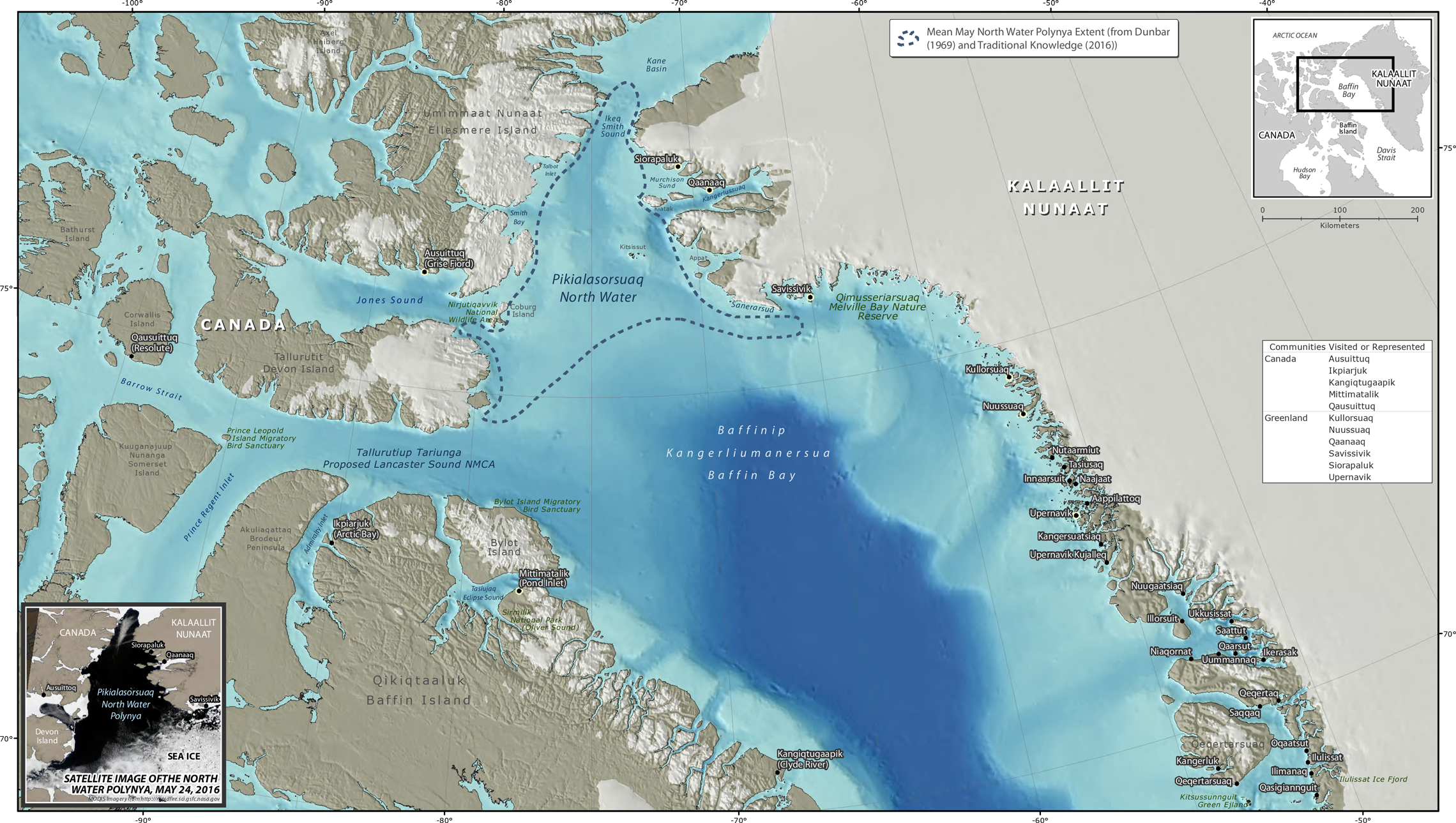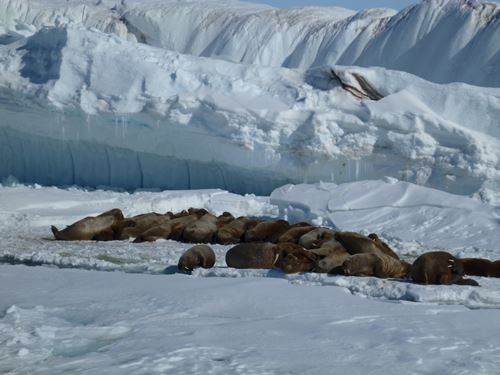About the Polynya
PIKIALASORSUAQ: A BIOLOGICAL HOTSPOT
Pikialasorsuaq (The North Water Polynya), or “The Great Upwelling” in Greenlandic, is the largest Arctic polynya and the most biologically productive region north of the Arctic Circle. Pikialasorsuaq has been recognized by Inuit for generations as a critical habitat. Communities in the Qikiqtani (Baffin Island) and Avanersuaq (North West Greenland) regions continue to rely on the polynya’s biological productivity. Pikialasorsuaq is vital to many migratory species upon which these communities, as well as farther afield, depend.
In some recent years, the northern ice bridge in Kane Basin, Nares Straight and Ikeq (Smith Sound) has become less reliable and the polynya less defined. The consequences of these changes, linked to larger climatic shifts observable in many parts of the Arctic, are not known.
What is a polynya?
In short, a polynya is an open water area surrounded by sea ice in polar regions. A study from 2017 on the North Water polynya by researchers Barber, Marsden, Minnet, Ingram & Fortier describes a polynya in more details:
"Polynyas are large areas (10–90 000 km2) of open water or reduced ice cover in the midst of the thick ice pack that cover polar oceans during much of the year. By remaining open in winter or becoming ice-free early in spring, polynyas serve as feeding, mating, spawning and over-wintering grounds for a diverse and populous bird and mammal community. Accordingly, polynyas have been compared to oases in terrestrial deserts."
Read their full article here:
Physical processes within the North Water
MAP OF PIKIALASORSUAQ

Above, you can see a map of Pikialasorsuaq, which is located between Baffin Island in Canada and North West Greenland. The border shown is a mean extent in May, combined from scientific data and traditional knowledge. A satellite image at the lower left shows an example of how the polynya looks in real life.
Inuit communities on both sides are also shown on the map, and communities that the Pikialasorsuaq Commission visited are indicated with a yellow circle. Representatives from other communities, that were not visited but participated in consultation meetings, are included in the list shown on the right.
Marine protection areas on both sides are indicated with green text. On the Greenlandic side it includes:
- Melville Bay Nature Reserve at Qimusseriarsuaq
- Ilulissat Ice Fjord
- Kitsussunnguit - Green Ejland
On the Canadian side it includes:
- Nirjutiqavvik National Wildlife Area
- Prince Leopold Migratory Bird Sanctuary
- Bylot Island Migratory Bird Sanctuary
- Sirmilik National Park (Oliver Sound)
The Proposed national marine conservation area for Tallurutiup Tariunga / Lancaster Sound in Canada is also shown with black text.
WILDLIFE RELATED TO PIKIALASORSUAQ
Pikialasorsuaq is the most biologically productive region north of the Arctic Circle due to a number of reasons. The most important is that the strong ocean currents push up warm and nutrient-rich water from the deep towards the surface, and the lack of ice allows the sun to reach the surface waters. This creates the perfect conditions for phytoplankton to bloom earlier and in larger masses than in surrounding areas.

The polynya also supports life indirectly, such as crustaceans and bottom-dwelling organisms in the deep waters or large bird colonies by the shores in nearby areas – as well as the Inuit communities in Greenland and Canada relying on the polynya’s biological production.
Below is a list with examples of wildlife that are directly or indirectly associated with the polynya:
- Plankton: Phytoplankton, Zooplankton including Copepods
- Fish: Arctic char, Arctic cod, Greenland cod, Greenland halibut
- Birds: Alcids, Arctic skua, Arctic tern, Atlantic puffin, Black-legged kittiwake, Common eider, Ivory gull, Little auk, Northern fulmar, Sabines gull, Thick-billed murre
- Marine mammals: Beluga, Bearded seal, Bowhead whale, Harp seals, Hooded seal, Narwhal, Ringed seal, Polar bear, Walrus
- Crustaceans: Northern shrimp
- Bottom-dwelling species: Anemones, Clams, Crabs, Scallops, Sea worms, Sea stars, Sponges